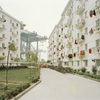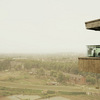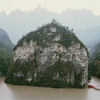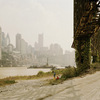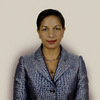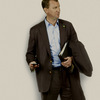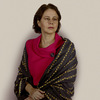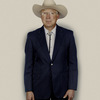A Conversation with Nadav Kander
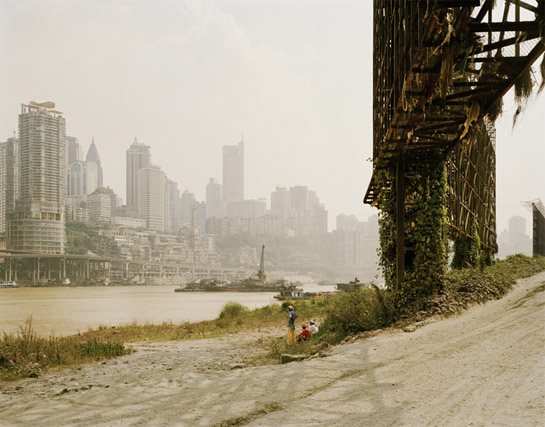
The work of Nadav Kander has always fascinated me. My curiosity only grew when seeing Obama’s People and later working on the review of Yangtze, The Long River. I finally approached Nadav and asked him whether he had a moment to talk about his work. I’m grateful he did. Find our conversation below. (more)
Jörg Colberg: How did you come up with the idea of doing the Yangtze River project?
Nadav Kander: I don’t generally work like that. There wasn’t first an idea and then off I went to take pictures. I suppose I always look for places on the edge of uneasiness, I’ve called them troubled lands in the past. China seemed to be a place moving at such an unbelievable pace, changing so quickly, that it would be a place that would be very interesting for me to go and photograph the way I do. I think of things more that way.
I photograph very intuitively and try to see what affects me in the place, rather than documenting what a place is. The Yangtze River was a way of giving me a pathway through China that would keep me on a certain route. It’s a great metaphor for change, of course, and also very much spiritually in the hearts and minds of most Chinese people.
JC: Given what you just said, I take it you did not really prepare much for the trips? You went and looked? Or did you look into Chinese history and into the background a little bit?
NK: The information that I will tell you about China was found out much later. I would first go there very open-mindedly. I made a trip to the mouth of the river and then halfway up the river to Chongqing. And then as I came back I would learn little things, I would read on China. It’s the extraordinary things I read that made me return. But each time I would return it became more and more conscious what was affecting me there and how I was responding to it. Then I could go back, do similar things, try to slip into the same way of working, and slowly a body of work forms. That’s more how I work.
JC: So things were very organic. It grew out of its own?
NK: Yeah. I think that the amount of time I spent on it really shows in the work. Had I gone there and made one trip over two or three months I’m sure my work would have appeared much more documentary-like. Although it has become a sociological document, it was never intended to be a documentary project.
JC: You don’t speak Chinese, do you?
NK: No.
JC: So you had to rely on interpreters and on people helping you get around and maybe even to get permissions. How was that, relying on other people to help you in certain situations to take photographs?
NK: Really difficult. There was a great person who accompanied me, an American. That made it a bit easier. But when I was working with a translator and a driver who were Chinese often, after a few days, a mist of mistrust would come over the thing. I think it would be heightened for them by being yelled at by the public sometimes: “How can you let these foreigners photograph the streets of our town?” They come from a very Communistic culture, where the only useful photography is certainly camera-club like, always photographing the sunset or the views of famous bridges. People got a lot of stick who worked with me. That often broke things down after about ten or twelve days.
JC: You mentioned that in your book, where you say that some of the people were taunting your translators.
NK: Yeah. I think they found it really difficult. It all started of with the best intentions, and they’re very generous people, but after a while they really had a hard time understanding how I worked. I couldn’t tell them what I was looking for. I needed just to look, and then when I found what I was looking for I might be excited by it. They absolutely couldn’t understand it.
JC: This must be a very difficult situation. You ended up with the photographs that you wanted, though, right? Or were there situations where you couldn’t just photograph because it became impossible?
NK: There were. One instance was when I was photographing closer to Tibet, which is a very military area. Wherever we went we were followed. It was very difficult to get any pictures of that area, they thought we were taking pictures of this highest railway in the world. So once they were onto me that area became impossible. But generally I found it free and accommodating and fine. I don’t know if I was followed or there’s a file on me.
JC: If a lot of the Chinese people didn’t really understand why you were taking those photographs in some ways it’s similar to people complaining that a lot of contemporary photography is “boring.” A lot of people in the West also love photographs of sunsets and something that’s beautiful, the beautiful landscape photograph. For you, when you see a picture or a scene that you want to take a photograph of - what is the appeal of that which you see? If somebody came up to you and said “why is this photo not boring? Can you explain this?” what would you say?
NK: I think it’s a universal Western truth that we have a real problem thinking any lower than our head into how we feel about things. I think when we are always trying to make our brain do the work and separate a picture into why I like it or why I don’t and what are the reasons for it, it’s often as simple as that it touches me in an emotional place, in a place inside me that responds to this for whatever reason. Maybe the way I was brought up, maybe the way my parents were brought up. Who knows how far these things go? We all have a problem in knowing that.
Good art works on that level very, very well. Think of Rothko as an excellent example. There’s almost no information on the canvas, and people can sit in front of them for hours, with very, very strong feelings. So composition in itself and weight of composition and colour can give you very strong connections to you and your past. I think that probably explains it.
But I would say to people, if I was going to simplify it, that I photograph everyday situations that compositionally attract me in a very beautiful way. What’s probably more succinct is what is boring is something that is just beautiful. Beauty, like yellow or red or boy or girl, is just a word.
JC: I was gonna ask you something that’s related a little bit to something you said earlier. There are photojournalism and documentary photography, and we always think of those as very different from what artists do. I’ve always thought that a book like the one you did in a certain way is documentary. It’s just a different kind of documentary. Even though it is art it also informs us about a place.
NK: I think when you photograph new lands or new views with the clarity of a camera it always has a layer of documentary in it. But I think the intention of an artist needs to be away from documentary for it to fit into the art context. For it to fit into an art context it needs to reference or react to other art. I think it needs to sit well or change the direction of the mainstream. I think when you go and just document that isn’t one’s intention. That’s the main thing, the intention.
But of course, by photographing China with the clarity of the lens it of course becomes a sociological document, even though that wasn’t the intention. The intention was much more to make photographs the way I make them, which is to really go on automatic and to go with one’s feelings and let the humanness of the person making the work clearly show.
JC: I suppose it comes a little bit down to the question of truth, too. In documentary photography we wouldn’t argue so much about whether the images are true, whereas in art we would. But I think there is actually… maybe we can call it a poetic truth in the work, which, I think, can be used in some ways to learn about China. China seen through your eyes, even though there is the beauty in the images that you look for… there still is something that is simply true.
NK: Sure, but I think had I asked a person to stand still for me I would have manipulated it. If I waited for a sunset I would manipulate it. If I waited for very harsh light or rain I would manipulate it. Every decision you make before you let the light hit the film… all of those decisions are your decisions. It always completes that three-way triangle. Is it a landscape in front of you, or is it actually the person behind the lens that you’re seeing, and I think it’s very equal. I think whether it’s a portrait or a landscape there are three corners, you’ve got your scene, your artist, and the viewer. And with art all three interact pretty equally.
JC: Let me take that and be a little bold. Let’s apply that thinking to the pictures you did of the Obama people, the then new administration. You took their portraits. The different context aside, is there a different way for you to work, or do you still apply your vision?
NK: Obama’s people actually are a very good example, because most commercial work isn’t, because it’s so much about a collaboration. The more people collaborate the less it is distilled down to that single person behind the lens, and that triangle breaks down.
With Obama’s people it was a very clear idea with Kathy Ryan and myself to work in a similar way to how the Bechers work, where if you photograph multiple things in a very similar way you will very accurately see the differences. That was really the thinking with the Obama’s people.
In its accuracy it was probably not in the normal realm of what Americans or people in the West see as celebrity photography. It certainly didn’t glorify people. It was really intent on being accurate. And I really like it.
In that same way it’s pretty similar to China because I’m again trying to not think about it, but just work with a person, without talking to them very much, and just willing them into being themselves. Nobody can be themselves better than themselves. If I can just let them be that, whether it’s nervous or very comfortable or however they are, very connected, not connected… when they are who they are knowing it and pressing the shutter. So in a funny way it’s a good question, they’re quite similar.
JC: I kind of thought that you would say that, but I didn’t want to assume anything.
NK: People quite often have asked me why my portraiture - my other portraiture, which is really quite different to Obama’s people - why does it often have the same kind of feeling as my landscape work. I would describe it in a similar way. With a landscape you might travel hundreds of miles and feel nothing, and then a little later suddenly you get out your car and the atmosphere is different. It all comes down to the atmosphere. And you start to photograph. Things feel right for you.
With portraiture I always start with an opinion and light accordingly. It’s not an opinion whether I like the person or their views or not, it’s more about how I can show them in an interesting way, which is the same with a landscape. And if it isn’t working - what if I asked them to turn slightly? Or what if I moved a light? - so it’s very similar, you’re making the atmosphere and taking advantage of it when it’s there in the room.
JC: The difference is in a landscape if something doesn’t work you can just get into your car and drive on, whereas in a studio you literally have to make it happen with what you have.
NK: That’s right. But what you’re doing is changing the circumstances so that you can then react to the atmosphere. It’s not really making the atmosphere, it’s more changing the circumstances so that the two come together.
Again when you look at a portrait do you think you’re looking at that person, or do you think you’re looking at the person who made the picture? I think it’s incredibly equal - one is useless without the other.
top image: Chongqing II, Chongqing Municipality, (c) Nadav Kander; all images courtesy of and (c) Nadav Kander, Obama’s People photographed for thr New York Times
 By
By 